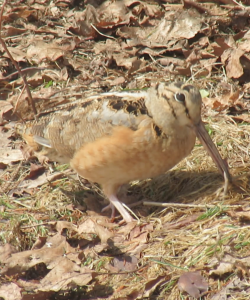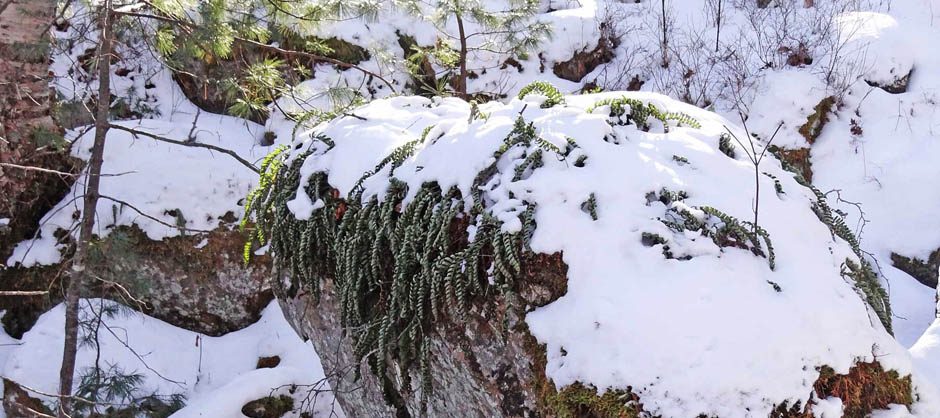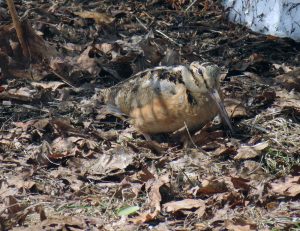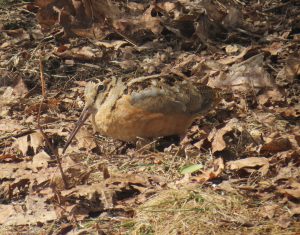Go To Ground-Nesting Birds 2024 for an Intro to this series & Links to other pages
Aug 28, 2024
Say hello again to the American Woodcock! This unusual shorebird is one of 4 ground nesting birds species that we’re featuring this season.
The American Woodcock lives in wooded or shrubby areas where the ground is damp, and is quite distinctive: a plump chest and belly, very short legs, big dark eyes placed unusually far back on the head, and a very long beak. They are a stocky bird, about the same length as a robin but more than twice as heavy! And the females are even larger than the males.
These attributes keep the bird close to the ground, able to keep watch for predators as they probe deep into the moist earth or leaf litter for their favourite food, earthworms.

Audubon Migration Map for American Woodcock
The Woodcocks that migrate to the Backlands don’t travel far, relocating to the southeastern United States for the winter – traveling slowly at night. In the daytime though, you might catch a Woodcock’s rocking disco walk as it crosses a road or path.
Help out the American Woodcock and all other ground nesting birds by keeping your rocking disco walk on the trails from March to September!
- – The Bird Team: Joshua Barss Donham. Fulton Lavender, Cathy Smalley, Katie Studholme
May 5, 2024
By The Bird Team: Joshua Barss Donham. Fulton Lavender, Cathy Smalley, Katie Studholme

American Woodcock strutting near Lake Banook, Dartmouth
View short Video by Joshua Barss Donham
What’s the most wonderful thing about the American Woodcock: The fantastic camouflage? The comical shape? The explosive flight with sound effects? The nicknames? Or the sublime funky Woodcock Walk? All these things make a Woodcock sighting very memorable.
Right now, probably the most important thing about the American Woodcock is that they are nesting – right on the ground. Help them out – when you visit the Backlands (or other wilderness areas around Nova Scotia), keep your feet on the trails!
Here’s a few more fun facts about the American Woodcock:
– The white tips on their tail are the whitest feathers of all bird species
– Their eggs are grayish orange with splotches of brown, violet-gray or blue-gray
– Males play no part in incubating or raising the young
– Their favourite snack is earthworms
– Their breeding stretches west to Winnipeg, south to Tennessee & north nearly to Labrador (check https://science.ebird.org/…/species/amewoo/range-map… for graphics)
– They have many nicknames: Bog Sucker, Night Partridge, Labrador Twister (possibly due to their sky dancing), and Timberdoodle (particularly popular here in Nova Scotia)
Whatever you call them, we hope you find something wonderful about this funny little shorebird. If they could, they’d thank you for keeping your pets close on the trails & watching your step from now til September, so they can safely raise their families!
Postscript, infor from Joshua: The photos/video were taken 8 April 2015 during the “fallout” of that year when migrating Woodcocks flying at night met a cold front over Halifax and came to ground in the hundreds seeking shelter and food. Halifax woke up to Woodcocks in backyards, in the middle of streets, even on sidewalks downtown among the high-rises. David Currie, then president of the NS Bird Society, wrote “Over a period of about an 1.5 hours and only along the main Road from Herring Cove to West Pennant including the village of Sambro, Ian McLaren and I counted 42 American Woodcock today!”.
Just waiting to hear from Fulton about occurrence in the Backlands. I know he’s found them nesting there in the past. During the Common Nighthawk survey last year (8 July 2023) Fulton and I heard a single Woodcock at Osprey Ridge/Alabaster Way at about 4:30 AM.
April 1, 2024
This funny little feathered friend would like to thank you for sticking to the trails while they’re nesting – contrary to what we often think about birds, the American Woodcock makes its nests right on the ground.
Woodcocks are secretive and solitary. Their mottled reddish brown, gray, and black feathers make them almost invisible on the forest floor. They are so well hidden that they are often observed when startled – exploding from their hiding place with the air twittering through their wingtips!
 In the early spring, Woodcocks move to more open areas for courtship. Males put on a “sky dance” mating display for the females at dawn and dusk. They announce themselves with buzzy peent sounds & air twittering through their wings, as they spiral from 300ft heights.
In the early spring, Woodcocks move to more open areas for courtship. Males put on a “sky dance” mating display for the females at dawn and dusk. They announce themselves with buzzy peent sounds & air twittering through their wings, as they spiral from 300ft heights.
Woodcock hens then make a shallow nest on the ground in the leaf litter, laying as many as five eggs, one per day. If a Woodcock Mama feels the nest is being threatened they will lure the predator away by pretending to be an easy meal themselves – staggering and dragging a fake broken wing before abruptly flying off once they feel the predator has been successfully diverted!
 The eggs hatch in about three weeks. Unlike many species, Woodcock chicks leave the nest just hours after hatching, then spend about a month foraging with their mother before they head out on their own.
The eggs hatch in about three weeks. Unlike many species, Woodcock chicks leave the nest just hours after hatching, then spend about a month foraging with their mother before they head out on their own.
Help keep these little guys safe by keeping your feet & your dog’s feet on the trails from March – August.
– The Ground-Nesting Bird Group:
Joshua Barss Donham, Ilona Inman, Fulton Lavender, Cathy Smalley, Katharine Studholme
Page posted by David P 1Apr2023


